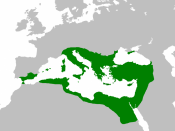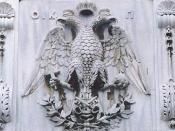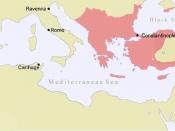Gabriela Guarino
Byzantine Art
In 395, the Roman Empire was divided into the east and west after the death of the Roman emperor Theodosius. Each side was ruled by one of Theodosius' two sons; Arcadius ruled the East Roman Empire and Honorius ruled the West Roman Empire. The west quickly fell apart after its capital was moved to Milan and then to Ravenna shortly following the sack of Rome in 410. The east, also referred to as the Byzantine Empire, was much more successful and remained strong up until the year 1453, when it was taken over by the Turks. Between the year that the east was given to Arcadius and the year it was captured, there was a period in which Byzantine art was in its greatest glory, which began in 527 and ended with the rest of the empire in 1453. This "golden age" of Byzantine art can be divided into three parts: early Byzantine art, middle Byzantine art, and late Byzantine art.
Much of the Byzantine Empires power was credited to the emperor Justinian, who ruled from 527 to 565. Throughout his ruling, he worked on things such as Corpus juris civilis (Code of Civil Law), which later became the foundation of the law systems in many European nations, and was considered to have revived the glory of "Old Rome" in New Rome. In the years of his accession, Byzantine art created its own distinct style, which worked to influence the art that came later on. The early Byzantine art period was well known for its architecture and the mosaics that decorated it. One of the most important monuments of Early Byzantine art is the Hagia Sophia. Located in Constantinople and designed and built by Anthemius of Tralles and Isidorus of Miletus between 532 and...


